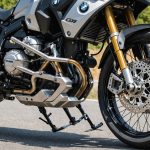Introduction to Headlight Beam Adjustment
Ensuring your vehicle’s headlights are correctly aligned is paramount for maintaining road safety. Proper headlight adjustment not only improves visibility for drivers but also prevents the glare that could momentarily blind oncoming traffic. This essential safety measure should not be overlooked.
Headlight Adjustment Basics
Several factors can affect the alignment of headlights, such as changes in a vehicle’s load or impacts that may have altered the settings. Familiarity with the types of headlight beams, including low beam and high beam, is crucial. Low beams are angled downward for moderate distance visibility, and high beams extend further with brighter intensity.
This might interest you : What modifications can improve the comfort of your motorcycle for long rides?
Adjusting headlight beams involves more than simply knowing beam types; it requires specific tools. Essential tools include a screwdriver, a measuring tape, and a wall or garage door to evaluate the headlight pattern. Using these tools, drivers can ensure headlights are aligned horizontally and vertically at the correct angle.
Recognising the importance and methods of headlight adjustment is crucial for both driver and pedestrian safety. By regularly checking and adjusting their headlights, drivers can significantly reduce the risk of accidents and improve the overall driving experience.
Additional reading : Step-by-Step Guide: How to Tighten Spokes on Your BMW F750GS for Enhanced Performance
Preparing for Adjustment
When preparing to adjust your Indian Chief Dark Horse, having the right tools and setup is essential. A comprehensive list of tools can simplify this process significantly. You will typically need a set of metric sockets, screwdrivers, spanners, and an Allen key set. Additionally, a torque wrench is ideal for ensuring all bolts are tightened to the manufacturer’s specifications.
Setting up your Indian Chief Dark Horse for adjustment ensures safety and efficiency. Begin by parking your motorcycle on a level surface and ensure it’s stable using a quality bike stand. Adequate lighting is crucial to spot any issues or bolts that might need adjustment. Before starting, gather your tools within easy reach to prevent unnecessary interruptions during the process.
Safety precautions are pivotal before any adjustment. Wear protective gloves to avoid injuries from sharp components, and ensure the engine is cool to prevent burns. It’s advisable to review the motorcycle’s manual to understand specific torque settings and regular maintenance protocols. This approach not only safeguards you but also enhances the longevity and performance of your Indian Chief Dark Horse.
Step-by-Step Adjustment Process
Adjusting motorcycle headlights is a crucial task to ensure optimal visibility and safety.
Step 1: Locating the Adjustment Screws
The adjustment screws on a motorcycle are typically located near the headlight housing. For the Indian Chief Dark Horse, these screws are often found at the back or sides of the headlight. Sometimes, you might need a Phillips screwdriver or a hex key to adjust them. Understanding this location is vital before embarking on any adjustment process.
Step 2: Measuring Proper Beam Height
To measure the proper beam height, park your motorcycle about 25 feet from a wall on a level surface. Your headlight’s centre should be aimed at a point approximately three feet high on the wall. This technique ensures correct vertical alignment, crucial for visibility without blinding oncoming traffic.
Step 3: Adjusting Horizontal and Vertical Angles
While making adjustments, you should simultaneously check and adjust both horizontal and vertical angles. Refer to the Indian Chief Dark Horse specifications, which suggest aligning the beams to achieve a balance between path illumination and oncoming driver’s comfort. Avoid tilting the beam too high or low, a common mistake.
After initial adjustments, check alignment by riding at night in a controlled, safe environment to assess real-world performance and make necessary fine-tuning.
Optimizing Headlight Performance
Enhancing motorcycle visibility is crucial, especially when it comes to the Indian Chief Dark Horse. One of the key factors to consider is the beam focus and spread of the headlights. Proper focus ensures that the light reaches a longer distance ahead while minimizing blind spots, hence increasing safety during night rides. Equally important is the beam spread, which provides a broader field of view and helps to spot hazards on the road early.
Several bulb types are recommended for the Indian Chief Dark Horse. Halogen bulbs are a common choice due to their balance of brightness and affordability. However, for those looking to enhance visibility further, LED bulbs are an excellent option. They offer brighter illumination and longer lifespan, making them a practical solution for many riders.
Regular maintenance is vital to ensure that headlight performance remains optimal. This includes checking for dirt or residue on the headlight cover and cleaning it as necessary. Inspecting the bulbs periodically to ensure they are functioning properly and replacing them if there are signs of dimming is also essential. Remember, maintaining headlight performance not only enhances visibility but also significantly contributes to overall riding safety.
Common Issues and Solutions
Encountering problems with your vehicle’s headlights can be both frustrating and dangerous. Understanding troubleshooting headlight problems is essential to ensuring road safety. One prevalent issue is misaligned beams, often resulting from rough terrain or minor accidents. When headlights are improperly aligned, they may not illuminate the road adequately, or worse, blind oncoming drivers.
Addressing this involves adjusting the angle and direction of the beams. Start by parking on a level surface and facing a wall. Measure and mark the exact position where the beams hit. Adjust the headlight screws until both beams are at the same height and angle.
Uneven lighting can also be a symptom of bulb issues. Troubleshooting headlight problems might reveal that a bulb is about to fail or has been improperly installed. In this case, check the bulb’s installation and replace it if necessary. Always ensure compatibility with your vehicle’s make and model.
Sometimes, professional help becomes necessary, particularly with electrical issues or persistent alignment problems. Consulting a technician ensures your vehicle’s headlights operate correctly and reliably, keeping you safe on the road. Remember, effective troubleshooting headlight problems can have a significant impact on overall driving experience.
Summary of Key Takeaways
Proper headlight adjustment is critical for safe driving, especially during night-time or low visibility conditions. Regularly following a simple set of steps ensures your headlights are aligned correctly, providing optimal road visibility without blinding oncoming traffic. Begin by parking your car on a level surface facing a plain wall or garage door, with ample space for adjustment work. After your vehicle is in place, consult your owner’s manual for the specific headlight adjustment procedure, as designs may vary slightly among manufacturers. Properly adjusted headlights offer the benefit of clearer visibility of road signs and potential hazards, which significantly enhances driver safety.
Routine checks of headlight alignment are easy and should become a part of your vehicle maintenance routine. Misaligned headlights might sometimes be an overlooked aspect of car care, yet the benefits in terms of safety are invaluable. Adopting these practices not only promotes safety but also ensures compliance with traffic regulations, further emphasising the importance of maintaining proper headlight positioning. Remember, even minor bumps or prolonged usage can shift headlight alignment, making regular checks and adjustments essential. Thereby maintaining both driver awareness and road safety.
Understanding Headlight Beam Adjustment
Proper headlight adjustment is crucial in ensuring safety on the road, particularly for motorcycles. Misaligned headlights can cause glare, impairing the visibility of other road users, and reducing the motorcyclist’s ability to see the path clearly. As part of regular motorcycle maintenance, tuning the headlight aim is not only a safety procedure but also a guideline-compliant activity.
There are generally three types of headlight beams: low beam, high beam, and fog lights. Low beams are designed to illuminate a large area in front of the motorcycle without blinding oncoming traffic. High beams, on the other hand, provide visibility over longer distances and are typically used in low-traffic or rural settings. Fog lights are positioned lower to cut through dense fog and provide improved ground visibility.
Compliance with headlight regulations and guidelines is essential. These norms ensure that headlights are not mounted too high or low, providing adequate lighting in all road conditions. Regulations vary by region but generally dictate the height and angle at which a headlight should be set. Proper following of these guidelines not only supports personal safety but also aligns with legal standards.
Tools Required for Headlight Adjustment
Adjusting your motorcycle’s headlights requires the right equipment. Here’s what you’ll need in your motorcycle toolkit for effective beam adjustment.
To start, you’ll want a Torx wrench and a Phillips screwdriver, as they’re fundamental for loosening and fastening headlight screws. Additionally, a flashlight can be handy for inspection – it ensures precision while adjusting the beam. An adjustable wrench might also prove useful for minor adjustments on specific models.
When it comes to purchasing quality tools for beam adjustment, consider brands known for durability and reliability. These tools are an investment that ensures your headlight remains correctly angled, enhancing both safety and visibility on the road.
If you’re into DIY, some alternatives allow adjustments with everyday items. However, these should only be temporary solutions. For example, a sturdy butter knife can substitute a flathead screwdriver in a pinch, though it lacks the precision of dedicated tools. Always prioritise using the right equipment when possible to prevent damage to your motorcycle’s components.
Safety Precautions Before Adjustment
When preparing for motorcycle adjustments, prioritising safety tips is essential. Ensuring your personal safety begins with wearing the appropriate gear. Use sturdy gloves, protective eyewear, and a helmet to prevent injuries. Closed-toed shoes should also be worn to protect your feet from heavy parts.
It’s crucial to organize your workspace for safety and efficiency. Conduct thorough garage safety checks before starting your work. This includes ensuring your workspace is well-lit and free of clutter to prevent accidents. Make sure that all tools are placed in easily accessible areas and are in good working condition.
Properly securing the motorcycle is another fundamental aspect of motorcycle adjustment safety. Utilise a quality centre stand or a robust lift to stabilise the motorcycle and prevent it from tipping over. Ensure that any part detached during the adjustment is placed safely to avoid mishaps.
These working precautions not only safeguard you but also ensure a smooth and efficient adjustment process. Keep these safety tips in mind, and you will create a secure environment for motorcycle adjustments.
Step-by-Step Guide to Adjusting Headlight Beam
Before jumping into the headlight adjustment process, it’s crucial to prepare your motorcycle for this task, ensuring accuracy and effectiveness. This DIY motorcycle maintenance procedure can enhance visibility and road safety.
Preparing the Motorcycle for Adjustment
To begin with, park your motorcycle on a level surface facing a wall or garage door. Ensure the bike is in a vertical position by using a stand, which provides stability during the process. Remove any extra weight to simulate standard riding conditions. Check your motorcycle’s owner manual for specifics on headlight adjustment, as different models have slight variations.
Finding the Correct Adjustment Spot
Next, create a mark at the correct adjustment spot on the wall. This serves as a reference point for your headlight aim. Ideally, the mark should be at the same height as the centre of your motorcycle’s headlight and at a distance of about 25 feet from the headlight itself. This setup helps in achieving the appropriate angle and intensity of the beam.
Making the Actual Adjustments
To adjust, use the tools specified in the motorcycle manual. Turn the adjustment screws slowly to modify the beam’s direction. Ensure the centre of the beam aligns with the mark on the wall. After adjustments, take the bike for a short ride and verify the beam’s aim, making any necessary fine-tuning. Regularly check these settings to maintain optimal road visibility.
Troubleshooting Common Issues
Addressing headlight issues is essential for safe driving. Whether your headlights are dim or misaligned, understanding common problems helps in effective troubleshooting. One prevalent issue is flickering headlights, often caused by faulty wiring or dying bulbs. Ensure connections are secure and consider replacing the bulbs if the problem persists.
When headlights seem dim, first check the lens clarity. Grime can obscure the light, and a simple cleaning might restore brightness. If cleaning doesn’t help, inspect the car battery and alternator, as weak power sources can lead to dim lights.
Misaligned beams are another frequent concern. They might appear too high, dazzling oncoming traffic, or too low, limiting visibility. Adjust the beam’s angle using the headlight adjusters. However, if adjustments don’t rectify the issue, further troubleshooting may be required.
There are times when these DIY solutions might not suffice, and professional help becomes necessary. For example, an unexplained electrical issue causing headlight failure is something to bring to a mechanic’s attention.
By addressing these common mistakes and mishaps early, you can maintain optimal headlight performance and ensure safe driving conditions.
Maintenance Tips for Headlights
Maintaining your motorcycle’s headlights is crucial for both safety and performance. Regular checks are essential in your motorcycle upkeep routine. Periodically inspect the headlights for dirt or debris that may hinder illumination. Clean them gently with a soft cloth to ensure maximum brightness and avoid potential accidents caused by poor visibility.
Equally important is adhering to a bulb replacement schedule. Over time, headlights may dim, reducing their effectiveness. To prevent this, replace bulbs according to the manufacturer’s recommendations. This not only enhances safety but also contributes to the long-term care of your motorcycle.
To prolong the headlight lifespan, consider a few practical tips:
- Use high-quality bulbs to ensure durability and better performance.
- Avoid unnecessary high beam usage to reduce wear and tear.
- Periodically check wiring and connections to prevent potential electrical issues.
Incorporating these headlight maintenance practices into your routine will ensure your motorcycle remains in excellent condition, offering you a reliable and safe ride every time.










